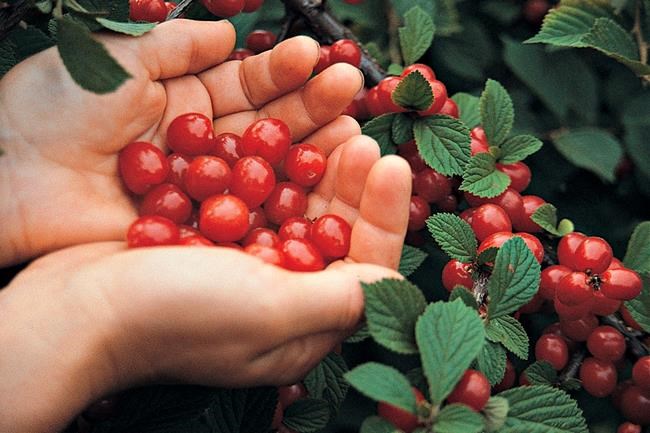There are many types of sweet or tart cherries you can grow
Advertisement
Read this article for free:
or
Already have an account? Log in here »
To continue reading, please subscribe:
Monthly Digital Subscription
$1 per week for 24 weeks*
- Enjoy unlimited reading on winnipegfreepress.com
- Read the E-Edition, our digital replica newspaper
- Access News Break, our award-winning app
- Play interactive puzzles
*Billed as $4.00 plus GST every four weeks. After 24 weeks, price increases to the regular rate of $19.00 plus GST every four weeks. Offer available to new and qualified returning subscribers only. Cancel any time.
Monthly Digital Subscription
$4.75/week*
- Enjoy unlimited reading on winnipegfreepress.com
- Read the E-Edition, our digital replica newspaper
- Access News Break, our award-winning app
- Play interactive puzzles
*Billed as $19 plus GST every four weeks. Cancel any time.
To continue reading, please subscribe:
Add Free Press access to your Brandon Sun subscription for only an additional
$1 for the first 4 weeks*
*Your next subscription payment will increase by $1.00 and you will be charged $16.99 plus GST for four weeks. After four weeks, your payment will increase to $23.99 plus GST every four weeks.
Read unlimited articles for free today:
or
Already have an account? Log in here »
Hey there, time traveller!
This article was published 02/07/2019 (2291 days ago), so information in it may no longer be current.
As a youngster, I never could get my fill of maraschino cherries. That is, until the day I got my hands on a whole jar of them, sat down with a spoon and proceeded to finish them off.
I haven’t put another maraschino cherry in my mouth since that sitting. So I can only rely on memory when I say that home-grown cherries taste much better.
And home-grown cherries encompass more than just the flavour of Bing, one of the most common varieties of sweet cherry offered fresh in markets this time of year. Bing is one of the many Bigarreau-type sweet cherries that make good commercial fruits because of their firmness.

There’s another whole category of sweet cherries know as Heart (or Gean) cherries that are notable for their soft flesh and heart shape. Black Tartarian is a Heart cherry that would be good to try in the backyard.
Birds, of course, love all sweet cherries, so be prepared to sacrifice part of the crop to them; insects and disease will likewise take their toll.
MORE KINDS OF CHERRIES
Tart cherries are easier to grow than sweet cherries. Some varieties grow on smaller trees, so could be netted against birds. In contrast to most varieties of sweet cherry, tart cherries do not need cross-pollination. So an isolated tree will bear fruit. Tart cherries also are more cold-hardy than sweet cherries and somewhat more resistant to pests. Northstar is a good variety of tart cherry to grow.
There’s yet another kind of cherry, little known on this side of the Atlantic but quite popular across that big “pond” — a natural hybrid of sweet and tart cherries. Duke cherries, as these are called, exhibit intermediate characteristics between their parents in both fruit and tree.
WILD AND SEMI-WILD, SOME TASTY
We’re finished here with the cherries you might find in supermarkets, but not with cherries you could grow. Some are barely edible, such as wild black cherry, whose wood makes wonderful lumber, and chokecherry.
Western sand cherry is a relatively small bush whose fruit is not edible “straight up,” but reputedly makes great jam. I’ve never made jam from my sand cherries but thoroughly enjoy just looking the shrub. The stems are enveloped in small, white blossoms in spring, and then are adorned throughout summer by glossy, bluish green leaves that turn salmon pink in autumn.
For the cherry that offers a little of everything, I recommend Nanking cherry. The fruit is tasty right off the bush and usually borne in such abundance that birds can’t make a dent in the crop. Those fruits are preceded by oodles of white flowers, and after the leaves have fallen, the shiny, peeling, copper-colored bark is pretty to look at.
Nanking cherry can take any amount of cold and heat, and demands no attention to pests or pruning.
Almost any of the cherries mentioned here could be made into maraschino cherries. Maraschinos were once made from a type of sour cherry called Marascas, but these days are made from any firm, sweet cherry, usually yellow varieties, but also under-ripe varieties that would have ripened to red.
If you want to try making your own maraschinos, boil some cherries in a 2-to-1 mixture of sugar and water, then add some red dye and almond extract. Another recipe calls for soaking the fruit, refrigerated, in a cider vinegar solution followed by a soak in sugar solution; then add the red dye and almond extract. I think I’ll pass, once again, on maraschino cherries.
___
http://www.leereich.com/blog
http://leereich.com

